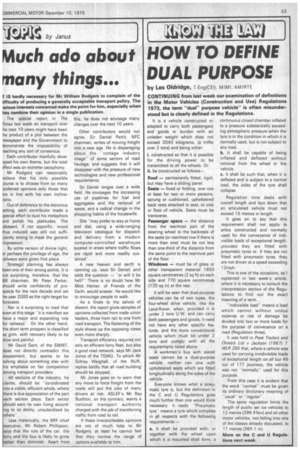HOW TO DEFINE DUAL PURPOSE
Page 83

If you've noticed an error in this article please click here to report it so we can fix it.
by Les Oldridge, T Eng(CEI) MIMI, AMIRTE
CONTINUING from last week our examination of definitions in the Motor Vehicles (Construction and Use) Regulations 1973, the term "dual" purpose vehicle" is often misunderstood but is clearly defined in the Regulations.
It is a vehicle constructed or adapted to carry both passengers and goods or burden with an unladen weight which does not exceed 2040 kilograms, (a triffle over 2 tons) and being either: i. constructed so that it is possible for the driving power to be transmitted to all the wheels. Or:
ii. be constructed as follows—
Roof — permanently fitted, rigid, but may have a sliding panel. Seats — fixed or folding, one row at least for two or more persons. sprung or cushioned, upholstered back rests attached to seat, or side or floor of vehicle. Seats must be transverse.
Passenger space — the distance from the rearmost part of the steering wheel to the backrests of the seats (or rearmost row if there is more than one) must be not less than one-third of the distance from the same point to the rearmost part of the floor.
Windows — must be of glass or other transparent material 1 850 square centimetres (2 sq ft) on each side and 770 square centimetres (120 sq in) at the rear.
It will be seen that dual-purpose vehicles can be of two types, the four-wheel drive vehicle, like the Land-Rover, when, provided it is under 2 tons U.W. and can carry both passengers and goods, it need not have any other specific features, and the more conventional vehicle which must be under 2 tons and comply with all the requirements listed above.
A workman's bus with slated seats cannot be a dual-purpose vehicle, neither can one with upholstered seats which are fitted longitudinally along the sides of the vehicle.
Everyone knows what a pneumatic tyre is, but the definition in the C and U Regulations goes much further than one would think necessary. It reads "Pneumatic tyre" means a tyre which complies in all respects with the following requirements:— a. It shall be provided with, or together with the wheel upon which it is mounted shall form, a continuous closed chamber inflated to a pressure substantially exceeding atmospheric pressure when the tyre is in the condition in which it is normally used, but is not subject to any load.
b. It shall be capable of being inflated and deflated • without removal from the wheel or the vehicle.
c. It shall be such that, when it is deflated and is subject to a normal load, the sides of the tyre shall collapse.
Regulation nine deals with overall length and lays down that an articulated vehicle must not exceed 15 metres in length.
It goes on to say that this requirement shall not apply to artics constructed and normally used for the conveyance of indivisible loads of exceptional length, provided they are fitted with pneymatic tyres or, if they are not fitted with pneymatic tyres, they are not driven at a speed exceeding 12mph.
This is one of the occasions, as I explained in last week's article, where it is necessary to consult the interpretation section of the Regulations to find out the exact meaning of a term.
"Indivisible load" means a load which cannot without undue expense or risk of damage be divided into two or more loads for the purpose of conveyance on a road (Regulation three).
It was held in Peak Trailers and Chassis Ltd v Jackson (1957) 1 WU? 285 that, where a vehicle was used for carrying invidivisible loads of exceptional length on all but 46 out of 177 journeys, the vehicle was not -normally" used for this purpose.
From this case it is evident that the word "normal" must be given its ordinary dictionary meaning of usual" or "regular".
The same regulation limits the length of public ser ice vehicles to 12 metres (39ft 43/4in) and all other motor vehicles, not falling into one of the classes already discussed, to 11 metres (36ft 1 in).
More on the C and U Regulations next week.
























































































































